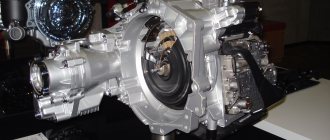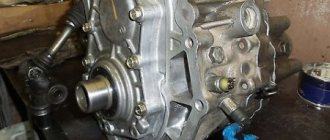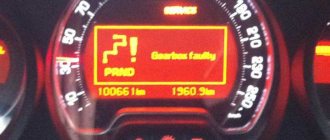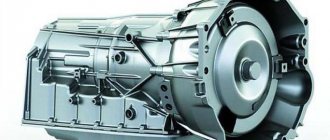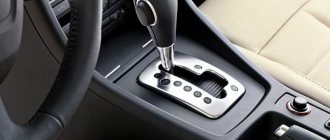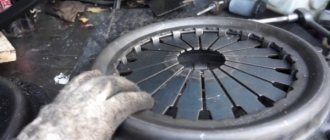Many car enthusiasts, when operating a car, often look for an opportunity to further increase engine power in order to improve acceleration dynamics and a number of other indicators. In other words, drivers perform engine tuning.
Moreover, such a solution is usually considered the main one in order to achieve a noticeable improvement in dynamic qualities and performance. Let us note right away that in fact this is not entirely true. The fact is that obvious improvements can be achieved by tuning the gearbox.
Transmission tuning: what is it for?
Let's start with the fact that comprehensive car tuning cannot be limited to “pumping” only the engine. First of all, the total amount of modifications will depend on how much the torque and power of the internal combustion engine increases. As a rule, if the performance of the power plant increases by 25-30% or more, the transmission, chassis, braking system, etc. will also require changes and improvements.
As for the gearbox, after boosting the engine (with or without installing turbocharging) or swapping the engine for a more powerful one, the standard gearbox on many cars may simply not withstand the increased torque. Even taking into account the fact that the manufacturer includes a safety margin in the transmission, this may not be enough. The result is a quick failure of the “stock” gearbox.
- Let's move on. Even if we take into account that the gearbox is quite durable, modifications are still necessary to take into account the changed engine performance. As part of gearbox tuning, the main task is to optimize gear ratios, that is, “tailoring” the gearbox to a specific engine.
To make it clear, in simple words, each gearbox is calculated in such a way that the internal combustion engine and transmission operate in optimal modes. Control of the manual transmission during active acceleration is simple. In a nutshell, you need to make sequential shifts, upping the gear at each speed interval at the moment when the tachometer needle is in the maximum power speed range.
Manual transmissions are capable of switching between different “speeds” by moving the gearshift lever, as well as squeezing the clutch pedal. The conversion of torque from the internal combustion engine is carried out through a stepwise transition from “lower” to “higher” gears. Also, with this gearbox you can “jump” through the gears, that is, after the 2nd gear, immediately engage the 4th, etc.
At the same time, for the best acceleration, it is important that the engine always operates in optimal mode. If, for example, you install a more revving and powerful engine, in this case with a standard gearbox such an engine will not be able to fully and effectively reveal its full potential.
- So, in order to reduce acceleration time, it is necessary that the transmission allows the engine in different gears to quickly and smoothly reach maximum power speeds (high “power” speeds) without loss in vehicle speed. As a rule, on manual transmissions for civilian cars, lower gears are “shorter”, and higher gears are made “long”, which is optimal for everyday use under normal conditions.
At the same time, a sporty driving style in a car with a forced engine paired with a standard gearbox can cause the driver a lot of difficulties and problems. The reason is that the gear ratio of a standard manual transmission usually has large gaps between adjacent gears.
Also, low gears are too “short”, which does not allow the driver to get enough traction in the selected gear, keep the engine at high speeds and move at the desired speed without upshifting. To put it simply, on a “stock” gearbox with a powerful engine, for example, in 1st and 2nd gear, the speed will rise very quickly, while the engine will never have time to reach its optimal mode.
On the one hand, the driver can actively work with the clutch, smoothly releasing the pedal when changing to each higher gear. This will allow the engine and gearbox to continue operating smoothly when changing gears, and it will also be possible to minimize the loss of revolutions when moving to a higher gear. However, in practice, even these methods do not provide such efficiency compared to what tuning a manual transmission can achieve.
From theory to practice
In order for a car to accelerate more dynamically, the gearbox must allow the engine to operate closer to the red zone of the tachometer scale for as long as possible. To do this, you just need to ensure that the gear ratios of each gear are closer to each other. Such transmission tuning will allow the engine speed to drop slightly during upshifts. Close transmission gears will also help when switching to a lower speed: even while driving at a decent speed, if necessary, you can safely shift “down” and accelerate acceleration without spinning the engine to the red zone of the tachometer.
Maximum acceleration will occur if the tachometer scale is in the red zone
The designers of production cars know about all this, but stock gearboxes often have “stretched” gears. It is no coincidence that engineers select transmission rows this way, because an ordinary car must satisfy a lot of other requirements, besides effectively “shooting” from a standstill to the coveted “hundred”. Firstly, such a car must be able to confidently reach the maximum speed declared by the manufacturer. To do this, the top gear must be quite “stretched” and with a small gear ratio. Secondly, the car must also move off no less confidently when standing on an incline, and here “short” lower gears are needed.
After tuning the transmission, the car accelerates much faster
How to be? There is a solution: gearbox tuning, in which new shafts and gears are made for a standard transmission housing. This work is very difficult and expensive. However, for owners of cars from our automobile industry there is a pleasant circumstance: Russia has accumulated considerable experience in such alterations. Here motorsport came to the aid of car enthusiasts, giving tuning enthusiasts, among other things, a large number of different rows and main transmission pairs. All this was mainly developed for VAZ cars with front-wheel drive.
Despite some differences, gearbox tuning is based on the same concept: lower gears are made more “stretched”, and higher gears are made “shorter” and closer together. This arrangement of gear ratios makes the process of starting off more sluggish, but subsequent acceleration will noticeably press the car crew into the seat backs.
When installing a different “filling” into a car’s transmission, do not forget that not every row is able to mate normally with the stock main pair. Although, there is room to roam around here. Tuning pairs with the following gear ratios are installed in the serial gearbox housing:
- 4,33
- 4,5
- 4,7
- 5,0
- 5,125
You can also install a short link designed to change the gear ratio in the shift drive. This solution is inexpensive and will make working with the transmission much easier.
There are even more exotic options than simply replacing a row in the gearbox. For a lot of money, anyone can assemble a real racing cam gearbox with six gears. This transmission allows the driver to select speeds without pressing the clutch, which significantly reduces acceleration time. However, to drive with a cam transmission, you must know how to handle it. In addition, it is a rather noisy unit. There are also gearboxes that do not require special racing training, but they are not installed on domestic cars. The design of a cam transmission is similar to a traditional one, only it has spur gears instead of helical gears, and cam clutches instead of toothed ones. “Cams” are designed to provide high speed gear selection, but shock loads quickly render them unusable.
Cam transmission is different from conventional transmission
Manual transmission tuning: features of modernization and modification of the gearbox
So, tuning a manual transmission often involves installing upgraded components into an existing gearbox housing. Moreover, depending on a particular task, there are many options (the gear ratios of individual gears change, the number of speeds increases to 6 or 7, etc.).
In any case, the basic principle when tuning the box is the following:
- it is necessary to make the “low” gears long so that the car can accelerate smoothly without shifting;
- higher gears, in turn, are made “shorter” and also move closer to each other in terms of transmission torques.
This kind of box tuning can greatly change the behavior and character of the car. For example, already in second gear you can quickly accelerate the car to high speed, while the speed on the tachometer will be optimal, and not in the red zone.
We also recommend reading the article about how tuning the engine fuel system is performed. From this article you will learn when tuning the engine power system is needed, as well as what results you can expect after implementing this modification.
Also, the tuning box allows you to load the transmission more, sharply switching to a lower gear for acceleration during overtaking and maneuvering. To achieve such results, standard gearbox gears are replaced with a tuned set.
The result is a manual transmission that operates more efficiently, withstands more load and allows the engine to reach its full potential. We also note that with tuning the gearbox and proper implementation of the project, even a relatively small engine in terms of volume and power allows the car to obtain outstanding dynamic characteristics.
The driver can also count on the necessary convenience; the process of driving a car during acceleration is simplified, and it becomes possible to implement various sports techniques. Let’s also add that instead of tuning the existing gearbox, another gearbox is installed. In some cases, this also allows you to get the desired result, however, swapping the box often requires additional work related to mounting the unit on the car and synchronizing it with the engine.
Automatic transmission tuning
Automatic transmission tuning is carried out in our automotive technical service ]Transmission Service Group[/anchor] (abbreviated as ATSC TSG) always professionally, quickly, at prices below market prices.
We have been working since 2007 and our main specialization is the repair of automatic transmissions of all currently existing types: automatic transmission, manual transmission, CVT, DSG, PowerShift.
At the same time, our general experience, staff of highly qualified specialists, equipment and tools allow us to repair any systems in cars. Our prices.
Automatic transmission tuning
Automatic transmission tuning - how it happens and what is needed for it. Preparing an automatic transmission for harsh operating conditions is a relatively new area of deep technical tuning. It is aimed at changing and improving the basic performance characteristics of automatic transmissions laid down by the manufacturer.
Professionally performed automatic transmission tuning allows you to:
- Increase transmission life.
- Reduce gear shift interval.
- Increase the acceleration dynamics of the car.
- Prepare the transmission for additional loads and long trips over difficult terrain.
Automatic transmission tuning – standard tuning package
The main modification in the standard tuning package is the installation of an additional cooling system. The standard tuning package consists of partial modification of the gearbox, automatic transmission and internal combustion engine cooling systems, and auxiliary devices to suit operating conditions:
- city traffic jams;
- prolonged movement at high speed;
- long-term towing of another vehicle;
- prolonged slipping when the car gets stuck in mud, snowdrifts, etc.
Additional cooling system
The standard cooling system does not always cope with its task of maintaining a certain temperature in the box during operation.
This depends on whether the car was manufactured for operation in climatic conditions and how often the cooling and oil circulation systems in the automatic transmission and internal combustion engine are diagnosed and flushed.
In case of excessive loads for which the automaker has not adapted the vehicle, an additional cooling system is installed.
Consequences of clogged cooling systems
Wear products accumulate in the system. By settling on the walls of the radiator, they significantly reduce its permeability.
The same thing happens on the outside of the radiator due to clogging with dust and dirt from the road. Heat transfer in the cooling system is significantly reduced, and the temperature in the box increases.
When the temperature threshold specified for the box is exceeded, oil seals and gaskets lose their elasticity, dry out, and this leads to leaks and disruption of the normal oil level. There is a drop in pressure in the automatic transmission system.
As a result, steel friction discs fail. During overheating, they burn, as a result of which the oil system in the box becomes clogged with dispersed dust, which has a dark color. Therefore, the oil in the box turns black with a burning smell.
If you are repairing a transmission with the intention of maximizing its service life without problems, it is worth checking and, if necessary, flushing the cooling systems of the automatic transmission and internal combustion engine.
This work should be performed by professionals. Flushing cooling systems yourself using clean oil and certain additives, in most cases, leads to most of the wear products getting into the box. As a result, the operation of the valve plate is most often disrupted.
Automatic transmission tuning – extended tuning package
The extended tuning package consists of a complete modification of the gearbox with its disassembly, automatic transmission and internal combustion engine cooling systems, and auxiliary devices for operating conditions:
- city traffic jams;
- increased loads when driving at high speeds;
- long-term towing of another vehicle;
- prolonged slipping when the car gets stuck in mud, snowdrifts, etc.;
- participation of the car in OFROAD, street racing;
- Constant use of the vehicle “off-road”.
With the extended tuning package the following are produced:
- installation of valve body tuning kits from SONNAX,
- strengthening of friction discs and separator plates,
- strengthening overrunning clutches,
- installation of an additional automatic transmission cooling radiator with a thermostat.
Features of the extended tuning package
Automatic transmission algorithms are quite complex. These algorithms have their own characteristics on different cars. Therefore, there is no ready-made standard solution for tuning automatic transmissions. The approach to automatic transmission tuning on a specific car is always individual.
The main things that can be changed in the operation of the automatic transmission:
- reduce gear shifting time ensuring fast acceleration;
- accelerate acceleration dynamics;
- significantly improve box cooling;
- improve the performance properties of the box through the use of special durable friction discs and clutches. Their working surfaces are made of materials that can withstand fairly strong friction loads and high temperatures.
If something is not installed
By reducing the gear shift time, the time interval between starts will decrease and the load will become more severe. If reinforced friction discs and clutches are not installed, then increased dynamic loads will destroy the clutches prematurely.
Also, with a reduction in gear shift time, heat generation increases. If an additional radiator is not installed, the service life of the box without repair is significantly reduced.
Our company has extensive experience accumulated over the years in the repair of automatic transmissions and their tuning
At ATSC TSG, we use only the most modern equipment and tools. The staff is formed only from highly qualified specialists. Diagnostics are always carried out quickly and faults are identified accurately.
Consultations are free and you can receive them using free communication methods. All our contacts.
Sign up for a free diagnostic
The site is maintained by the express web studio KONTENT24.RU
You may also be interested in:
Transmission parameters
The main parameter of the transmission is the passing torque. It is always necessary to ensure that its value is equal to the torque or slightly exaggerates it. If this is not done, and the torque is one and a half times greater than the throughput, then most likely you will simply break the gearbox. The main thing that can be modernized is to change the gear ratio on the main pair and make it higher. Thanks to this, the dynamics are enhanced, but the maximum speed of the car is reduced. If a person is not a racer, and the car is not for him to drive on tracks, then reducing the speed indicators is not so important. If desired, you can improve the gears, which will affect the acceleration, and it will become faster.
When do you need software tuning of the gearbox?
In most cases, reprogramming a foreign car with an automatic transmission is resorted to by users whose choice is fast and even aggressive driving. Often these are owners of Renault, Skoda, Nissan, Ford and other brands of sedans. The main signs of the need for chip tuning can be considered:
- There is a noticeable delay when changing gears.
- The characteristic twitching of a vehicle while moving in city traffic jams.
- Very smooth acceleration of the car (most noticeable if the movement starts downhill).
To solve the identified problems, it is proposed to order either a complete software update of the engine, or a local flashing of the automatic transmission. It is noteworthy that the results of the specialist’s manipulations will be noticeable almost immediately after leaving the workshop. Firstly, the car will be able to quickly move off, secondly, it will move without unpleasant jerking during rush hour in a metropolis, and thirdly, the transition to maximum gears will no longer resemble slow motion.
Interior tuning
Modified interior of a Peugeot 106.
Interior tuning includes reupholstering car interior elements (seats, dashboard, steering wheel, ceiling, etc.) with various materials (automotive leather, Alcantara, velor, etc.), replacing standard interior elements with more comfortable ones (most often this is replacing the seats and steering wheel with sports ones), modifying the interior by changing the shape or connecting various additional functions, such as heated and ventilated seats, lighting (light styling), heated steering wheel, massage covers for seats, etc.
Materials for tuning car interiors are separated into a separate group and are not suitable for other purposes due to their properties. For example, genuine automotive leather differs from furniture, haberdashery and any other leather in its thickness (it averages 1.2-1.7 mm) and additional degrees of protection, which extends the life of the car interior.

